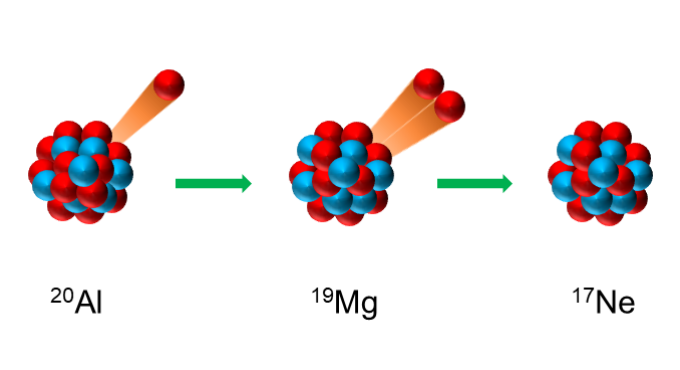Physicists Discover Aluminium-20, a New Three-Proton-Emitting Isotope
Radioactive decay is a fundamental process in nature by which an unstable atomic nucleus loses energy by radiation. Studying nuclear decay modes is crucial for understanding properties of atomic nuclei. In particular, exotic decay modes like proton emission provide essential spectroscopic tools for probing the structure of nuclei far from the valley of stability—the region containing stable nuclei on the nuclear chart.
In a study published in Physical Review Letters on July 10, physicists from the Institute of Modern Physics (IMP) of the Chinese Academy of Sciences (CAS) and their collaborators have reported the first observation and spectroscopy of aluminium-20, a previously unknown and unstable isotope that decays via the rare process of three-proton emission.
“Aluminium-20 is the lightest aluminium isotope that has been discovered so far. Located beyond the proton drip line, it has seven fewer neutrons than the stable aluminium isotope,” said Associate Prof. XU Xiaodong from IMP, first author of the study.
Using an in-flight decay technique at the Fragment Separator of the GSI Helmholtz Centre for Heavy Ion Research in Darmstadt, Germany, the researchers measured angular correlations of aluminium-20’s decay products and discovered the previously unknown nucleus aluminium-20.
Through detailed analysis of angular correlations, the researchers found that the aluminium-20 ground state first decays by emitting one proton to the intermediate ground state of magnesium-19, followed by subsequent decay of magnesium-19 ground state via simultaneous two-proton emission. Aluminium-20 is the first observed three-proton emitter where its one-proton decay daughter nucleus is a two-proton radioactive nucleus.
The researchers also found that the decay energy of the aluminium-20 ground state is significantly smaller than the predictions inferred from the isospin symmetry, indicating a possible isospin symmetry breaking in aluminium-20 and its mirror partner neon-20.
This finding is supported by state-of-the-art theoretical calculations that predict that the spin-parity of the aluminium-20 ground state differs from the spin-parity of the neon-20 ground state.
“This study advances our understanding of the proton-emission phenomena, and provides insights into the structure and decay of nuclei beyond the proton drip line,” said XU.
To date, scientists have discovered over 3,300 nuclides, yet fewer than 300 are stable and exist naturally. The remainder are unstable nuclides that undergo radioactive decay. Common decay modes, such as α decay, β- decay, β+ decay, electron capture, γ radiation, and fission, were discovered by the mid-20th century.
Over the past several decades, owing to the tremendous development in nuclear physics experimental facilities and detection technologies, scientists discovered several exotic decay modes in the study of nuclei far from the stability, particularly in neutron-deficient nuclei.
In the 1970s, scientists discovered single-proton radioactivity, where nuclei decay by emitting a proton. After entering the 21st century, two-proton radioactivity was found in the decays of some extremely neutron-deficient nuclei. In recent years, even rarer decay phenomena such as three-, four-, and five-proton emission were observed.
This collaborative effort included contributions from IMP, GSI, Fudan University, and more than a dozen other institutions.
This work was supported by the National Key R&D Program of China, the CAS President’s International Fellowship Initiative, and the National Natural Science Foundation of China, among others.
DOI: https://doi.org/10.1103/hkmy-yfdk

Figure. Illustration of three-proton emission from aluminium-20. (Image by XU Xiaodong)
Contact Information
Institute of Modern Physics
Email: LIU Fang


 甘公网安备 62010202000713号
甘公网安备 62010202000713号


